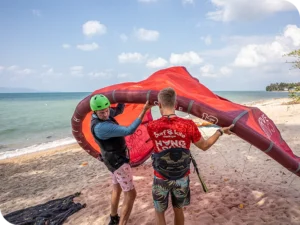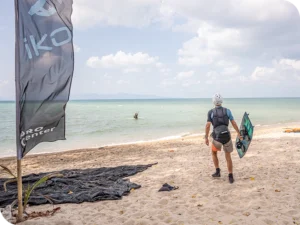Ko Pha Ngan, renowned for its picturesque beaches and vibrant cultural scene, beckons kiteboarding enthusiasts from around the globe. Yet, mastering the art of kiteboarding in this tropical paradise extends beyond mere skill—it demands a profound understanding of the island’s unique weather dynamics and conditions.
In this comprehensive guide, we’ll navigate through Ko Pha Ngan’s weather intricacies tailored specifically for kiteboarding aficionados. From deciphering prevailing wind patterns to anticipating tidal fluctuations, we’ll unravel the essential insights to ensure a fulfilling and safe kiteboarding experience on the island.
Understanding Ko Pha Ngan’s weather is crucial for optimizing kiteboarding sessions. The island’s wind patterns, influenced by seasonal monsoons and local topography, dictate the ideal spots and times for kiteboarding adventures. Additionally, comprehending tidal movements is essential for selecting suitable launch sites and maximizing riding opportunities.
With this guide as your compass, you’ll gain invaluable knowledge to harness Ko Pha Ngan’s weather to your advantage, allowing you to navigate its azure waters with confidence and finesse. Whether you’re a seasoned rider seeking new challenges or a novice eager to embark on your kiteboarding journey, unlocking the secrets of Ko Pha Ngan’s weather ensures an unforgettable experience on this idyllic island paradise.
Before setting sail on your kitesurfing escapade in Ko Pha Ngan, acquainting yourself with the island’s weather patterns is paramount. Nestled in the Gulf of Thailand, Ko Pha Ngan boasts a tropical climate characterized by two distinct seasons: the dry season and the wet season.
During the dry season, spanning from December to April, Ko Pha Ngan basks in balmy weather and clear skies. This period is marked by gentle breezes and stable wind conditions, offering prime opportunities for exhilarating kiteboarding sessions. Riders can expect consistent winds blowing predominantly from the northeast, providing ideal conditions for gliding across the azure waters surrounding the island.
Conversely, the wet season, which extends from May to November, brings a different atmospheric dynamic to Ko Pha Ngan. Characterized by sporadic rainfall and occasional thunderstorms, this season introduces variable wind patterns that can pose challenges for kiteboarding enthusiasts. However, despite the unpredictable weather, the wet season also heralds stronger winds and larger swells, presenting adventurous riders with thrilling opportunities to conquer the waves.
Understanding these seasonal weather nuances is essential for planning your kiteboarding excursions in Ko Pha Ngan. By aligning your adventures with the prevailing weather conditions, you can optimize your riding experience and ensure maximum enjoyment while exploring the island’s breathtaking coastline. So, whether you’re chasing the gentle zephyrs of the dry season or embracing the wild winds of the wet season, Ko Pha Ngan’s diverse weather palette promises an unforgettable kitesurfing odyssey amidst its tropical splendour.
In Ko Pha Ngan, the seasons play a crucial role in shaping kiteboarding conditions, offering enthusiasts unique experiences throughout the year. Understanding the distinct characteristics of each season is essential for planning successful kiteboarding adventures on the island’s pristine shores.
The dry season, spanning from December to April, is synonymous with idyllic kiteboarding conditions in Ko Pha Ngan. During this period, the island basks in abundant sunshine and enjoys relatively stable weather patterns. The northeast monsoon prevails, ushering in consistent winds from the Gulf of Thailand. These steady winds, typically blowing from the northeast, create prime kiteboarding conditions along the island’s eastern and northern coasts. Kiteboarders can revel in long sessions of uninterrupted riding, harnessing the power of the winds to glide effortlessly across the crystal-clear waters.
Conversely, the wet season blankets Ko Pha Ngan from May to November, bringing higher humidity levels and occasional rainfall. Despite the intermittent showers, kiteboarding remains a viable pursuit during this period. However, riders must exercise caution and remain vigilant as the wet season introduces variable wind conditions and occasional storms. Monitoring weather forecasts becomes imperative, allowing kiteboarders to anticipate shifts in wind patterns and plan their sessions accordingly. While the wet season may present challenges, it also offers opportunities for exhilarating rides amidst the backdrop of dramatic skies and pounding waves.
Throughout both seasons, Ko Pha Ngan’s natural beauty and diverse kiteboarding spots continue to enthral enthusiasts from around the world. Whether you’re seeking the tranquil serenity of the dry season or the adrenaline-fueled excitement of the wet season, Ko Pha Ngan’s ever-changing weather landscape promises an unforgettable kiteboarding experience for riders of all skill levels. So, whether you’re soaring through the skies or carving through the waves, embrace the seasonal rhythm of Ko Pha Ngan and let the winds guide you on your kitesurfing journey.
To maximize your kiteboarding experience on this picturesque island, it’s essential to pinpoint the best months when weather conditions align harmoniously with the sport’s demands.
The pinnacle of kiteboarding perfection in Ko Pha Ngan unfolds during the months of December through March, marking the zenith of the dry season. During this period, the island is blessed with a delightful concoction of elements conducive to unparalleled kiteboarding escapades.
Picture-perfect sunny skies dominate the landscape, casting a golden hue over the azure waters that beckon kiteboarders from far and wide. Temperatures remain comfortably moderate, striking an optimal balance between warmth and coolness that enhances the overall enjoyment of the sport.
However, it’s the consistent winds that steal the spotlight during these months, propelling kiteboarders into a realm of exhilarating adventures. As the northeast monsoon sweeps across the Gulf of Thailand, it bestows upon Ko Pha Ngan a gift in the form of steady, reliable winds. These winds, which typically blow from the northeast, unfurl the canvas for thrilling kiteboarding sessions along the island’s eastern and northern coasts.
For kiteboarding enthusiasts, this convergence of favourable weather elements translates into an idyllic playground where dreams of soaring through the skies become a reality. Whether you’re a seasoned rider or a novice enthusiast, the months of December to March offer an unrivalled opportunity to indulge in the sheer bliss of kiteboarding in Ko Pha Ngan.
So, if you’re yearning for the ultimate kiteboarding adventure amidst breathtaking tropical scenery, mark your calendar for a rendezvous with Ko Pha Ngan during its prime kiteboarding season. Let the winds guide you as you embark on an unforgettable journey across the sun-kissed waters of this island paradise.
Understanding the island’s wind patterns and directions is paramount for planning successful and exhilarating sessions on the water.
Throughout the year, Ko Pha Ngan experiences two distinct wind patterns, each corresponding to the prevailing monsoon season. During the dry season, which typically spans from December to April, the island is under the influence of the northeast monsoon. This season brings about consistent and reliable winds that originate from the northeast direction. These winds sweep across the Gulf of Thailand, creating optimal kiteboarding conditions along the eastern and northern shores of Ko Pha Ngan.
The consistent northeast winds during the dry season provide kiteboarders with ample opportunities to harness the power of the breeze and glide gracefully across the turquoise waters. Beginners and experienced riders alike can take advantage of these favourable conditions to hone their skills and indulge in the thrill of kiteboarding against the backdrop of Ko Pha Ngan’s stunning coastline.
Conversely, during the wet season, which typically spans from May to November, Ko Pha Ngan experiences a shift in wind direction as the southwest monsoon takes hold. Winds during this season predominantly blow from the southwest, bringing about more variable conditions compared to the dry season. While kiteboarding is still possible during the wet season, kiteboarders should be prepared for fluctuating wind speeds and occasional storms, which can present more challenging kiteboarding opportunities.
Overall, a keen understanding of Ko Pha Ngan’s wind patterns and directions allows kiteboarders to plan their sessions strategically, optimizing their time on the water and making the most of the island’s unique kiteboarding opportunities. Whether it’s gliding effortlessly under the clear blue skies of the dry season or embracing the challenge of variable winds during the wet season, Ko Pha Ngan offers an unforgettable kiteboarding experience for enthusiasts of all levels.
In the realm of kiteboarding in Ko Pha Ngan, understanding the dynamics of monsoon winds is paramount. These seasonal winds wield considerable influence over the island’s weather patterns and, consequently, kiteboarding conditions.
During the dry season, which typically spans from December to April, Ko Pha Ngan experiences the northeast monsoon. This brings about a consistent and reliable flow of winds ranging between 10 to 20 knots, creating optimal conditions for kiteboarding. The steady winds provide kiteboarding enthusiasts with ample opportunities to hit the waves, irrespective of their skill levels. Whether you’re a seasoned rider or a novice looking to improve, the dry season’s northeast monsoon offers ideal conditions to indulge in the exhilarating sport of kiteboarding.
Conversely, the wet season, which occurs from May to November, introduces a shift in wind dynamics. During this period, wind conditions become more variable, characterized by gusty winds and occasional squalls. While kiteboarding remains feasible during the wet season, riders must exercise caution and adapt to the changing conditions on the water. Being prepared for sudden gusts and shifts in wind direction is essential to ensuring a safe and enjoyable kiteboarding experience.
In essence, the interplay of monsoon winds shapes Ko Pha Ngan’s kiteboarding landscape, dictating the ebb and flow of wind conditions throughout the year. By understanding and respecting these seasonal winds, kiteboarding enthusiasts can make the most of their time on the island’s pristine waters, embracing the challenges and thrills that come with each season.
Wind speed stands as a pivotal element that can either enhance or hinder the overall riding experience. Aiming for the sweet spot between 12 to 25 knots proves ideal for kiteboarders seeking optimal riding conditions.
Lighter winds, falling below the desired range, pose challenges, particularly for beginners. In such instances, larger kites become necessary to compensate for the lack of wind power. Generating sufficient power for riding becomes arduous, demanding riders exert more effort and finesse in manoeuvring their kites across the sky.
Conversely, stronger winds, exceeding the optimal range, introduce a new dimension of excitement to the kiteboarding experience. The rush of adrenaline amplifies as riders harness the raw power of the wind, propelling them across the water with exhilarating speed. However, with this heightened excitement comes the need for heightened caution. Controlling the kite and maintaining stability becomes more challenging, requiring riders to exert greater focus and skill to navigate the wind’s force effectively.
Understanding how wind speed influences kiteboarding is essential for riders in Ko Pha Ngan. By attuning themselves to the nuances of wind conditions, kiteboarders can adapt their techniques and equipment accordingly, ensuring a safe and enjoyable riding experience amidst the island’s breathtaking coastal landscapes.
awareness of tides and water conditions stands paramount in ensuring safe and enjoyable riding experiences. Tides, influenced by gravitational forces from the moon and sun, exert a profound influence on water depth and currents, directly impacting the suitability of kiteboarding spots.
Throughout the day, tides transition between high and low phases, causing fluctuations in water levels and currents along the coastline. Understanding these tidal patterns is crucial for kiteboarders, as it enables them to identify opportune windows for riding and select appropriate launch and landing spots.
During high tide, water levels rise, creating deeper and more expansive riding areas. Kiteboarders can take advantage of these conditions to explore new stretches of coastline and enjoy uninterrupted riding sessions. Conversely, low tide exposes shallow sandbars and reefs, altering the dynamics of the riding area and potentially posing hazards to riders.
Additionally, tidal currents play a significant role in determining the direction and intensity of water flow. Kiteboarders must consider these currents when planning their riding routes, ensuring they can efficiently navigate against or with the flow to optimize their riding experience.
By understanding tides and water conditions, kiteboarders in Ko Pha Ngan can make informed decisions regarding when and where to kiteboard, maximizing their safety and enjoyment on the water amidst the island’s stunning coastal landscapes.
understanding tide times and levels is paramount for planning successful and safe riding sessions. The island experiences two high tides and two low tides each day, with the timing and intensity of these tides influenced by the lunar cycle.
High tides occur when the gravitational pull of the moon and sun align, causing water levels to rise along the coastline. Conversely, low tides occur when this gravitational force diminishes, resulting in lower water levels.
The timing and intensity of these tides vary daily, making it essential for kiteboarders to consult tide charts to determine the optimal times for their riding sessions. By aligning their sessions with high tides, kiteboarders can access deeper water and smoother riding conditions, while low tides expose shallower areas and potential hazards.
Additionally, understanding the lunar cycle can provide insights into the magnitude of tide fluctuations. During full and new moons, known as spring tides, the gravitational forces of the moon and sun align, resulting in more pronounced high and low tides. Conversely, during quarter moons, known as neap tides, the gravitational forces partially cancel each other out, leading to lesser tide fluctuations.
By incorporating knowledge of tide times and levels into their kiteboarding plans, enthusiasts in Ko Pha Ngan can optimize their riding experiences, ensuring they make the most of the island’s breathtaking coastal scenery and diverse kiteboarding spots.
Understanding the impact of tides is crucial for kiteboarding enthusiasts navigating the waters of Ko Pha Ngan. Tides play a significant role in shaping the conditions at kiteboarding spots around the island, influencing water depth, currents, and the overall riding experience.
During high tide, kiteboarders can expect deeper water levels and stronger currents, creating ideal conditions for cruising and exploring the expansive coastal areas. However, riders must also be mindful of potentially stronger currents, which may require additional effort to navigate safely.
Conversely, low tide exposes sandbars and shallow areas along the coastline, offering unique opportunities for freestyle tricks and wave riding. Kiteboarders can take advantage of these shallower areas to practice jumps, turns, and other manoeuvres in a controlled environment.
Furthermore, the transition between high and low tide, known as the tidal flow, can create dynamic conditions characterized by changing water depths and currents. Kiteboarders must adapt their riding style and technique to accommodate these fluctuations, ensuring a safe and enjoyable experience on the water.
By understanding the impact of tides on kiteboarding spots, riders in Ko Pha Ngan can strategically plan their sessions to capitalize on optimal conditions, whether they’re seeking the thrill of high-tide cruising or the excitement of low-tide freestyle riding.
Koh Phangan, Thailand, benefits from a tropical monsoon climate, which brings three distinct seasons: the dry, hot, and wet seasons. This variability in weather Koh Phangan Thailand is crucial for kiteboarding enthusiasts to understand, as it directly impacts safety and enjoyment on the water.
During the dry season, typically from December to April, kiteboarders can expect clear skies, minimal rainfall, and consistent winds, making it an ideal time for kiteboarding. The hot season, from April to June, sees temperatures rise, accompanied by occasional brief showers, yet the winds remain favourable for kiteboarding.
Kitesurf Koh Phangan Current Weather with Windfinder.com









